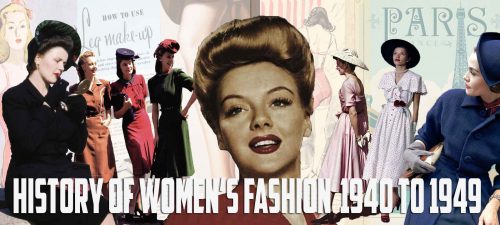World War Two Fashion
The Impact of War on 1940’s Fashion in the USA.
© 23/10/2012 Tia Craig
Click World War Two Influence on 1940s Fashion to read the full article from the beginning or to download the free ebook.
Now see the lavishly illustrated concise history of 1940s womens dress and style

When the men started going off to war, the women at home had to live a different lifestyle. Fashion was a large aspect of their lifestyle that had to be changed. They eventually learned to make do with what they had and to only buy what was necessary rather than wanted. Even though “fashion wasn’t important during this time” (Nelson) since attention was focused on the war, people still generally dressed formally “both before and after the war” (Lindop). Their typical attire included articles of clothing such as “hats, dresses, gloves, and stockings, while casual trousers, sweaters, and jackets were strictly” (Lindop) worn around the house.

Also, their shoes tended to be simple and sturdy and came in the styles of Oxfords, pumps and sandals.As a part of the Limitation Order, “Women’s clothing was covered by L-85.” (Walford). This order altered the dress code for women by restricting and limiting certain fabrics, dyes, shoes, styles, and other fashion items. It is true that these were huge sacrifices for the women whereas in previous times, they had always felt the need to maintain a good appearance with their beauty and what they wore. However, one of the ways that the government tried to keep up their morale was to “not limit wedding dress materials, although excessively full skirts and long trains were rare and silk was not available – only rayon satins, crepes, and taffetas.” (Walford).

The war transformed fashion styles into a much simpler way to merge with the new lifestyle.
In the early forties, “a model named Miss Chemistry introduced nylon stockings.” (Lindop) which “were a hit with female shoppers.” (Lindop) because they were much cheaper and easier to care for than silk stockings which were worn before nylons. Furthermore, silk stockings were “very valuable and important” (Nelson) at this time and it was very rare for women to obtain these particular ones as silk was used for war materials. Due to L-85, clothes had to be made of fabrics that were simplified and easier to come by so they were made of either “Wool, cotton, linen, or easy-care synthetics” (“1940’s Fashion – Women’s Dress Code in the War Years.”, Glamour Daze.) Unfortunately, most of these materials as well as nylon, silk, and leather were needed for the soldier’s clothing and equipment so American women had to make do without having new clothes. This of course changed the dress code as they had to find alternative methods to getting new clothes. This is where the booklet called Make and Mend became useful because it “gave helpful hints on cleaning and maintaining clothing and linens, avoiding moths, recycling woolen sweaters, and patching and making over older, worn clothes.” (Walford). In addition, “Home sewing was becoming increasingly popular” (Walford) which went hand-in-hand with the booklet.

Women became very clever with making do with what they had. For instance, to solve the lack of owning stockings, some women would draw “lines up the back of their legs to look like stocking seams” (Lindop) with a makeup pencil or even paint on a film of specialized paint makeup to make it appear like stockings. They also “mended and patched old clothes, wore hand-me-downs and stitched together old pieces of fabric to make new outfits.” (Lindop). People these days may find it puzzling as to why women were so desperate to go to such measures as making it look like they were wearing stockings.People nowadays are unaware of the circumstances of that time and that “It was against social convention to go bare-legged other than at home or the seaside, and so the problem was greater for women of the 1940s than can be understood from a modern perspective.” (Walford). It was not too long for most of the people on the home front to accept their roles in the war and the sacrifices that they needed to make, but it was only the “very tall and the portly.”(Walford) who found the major reductions to clothing a big issue.
copyright 2012 Tia Craig
Next Chapter – 7. Women’s Role during World War Two

